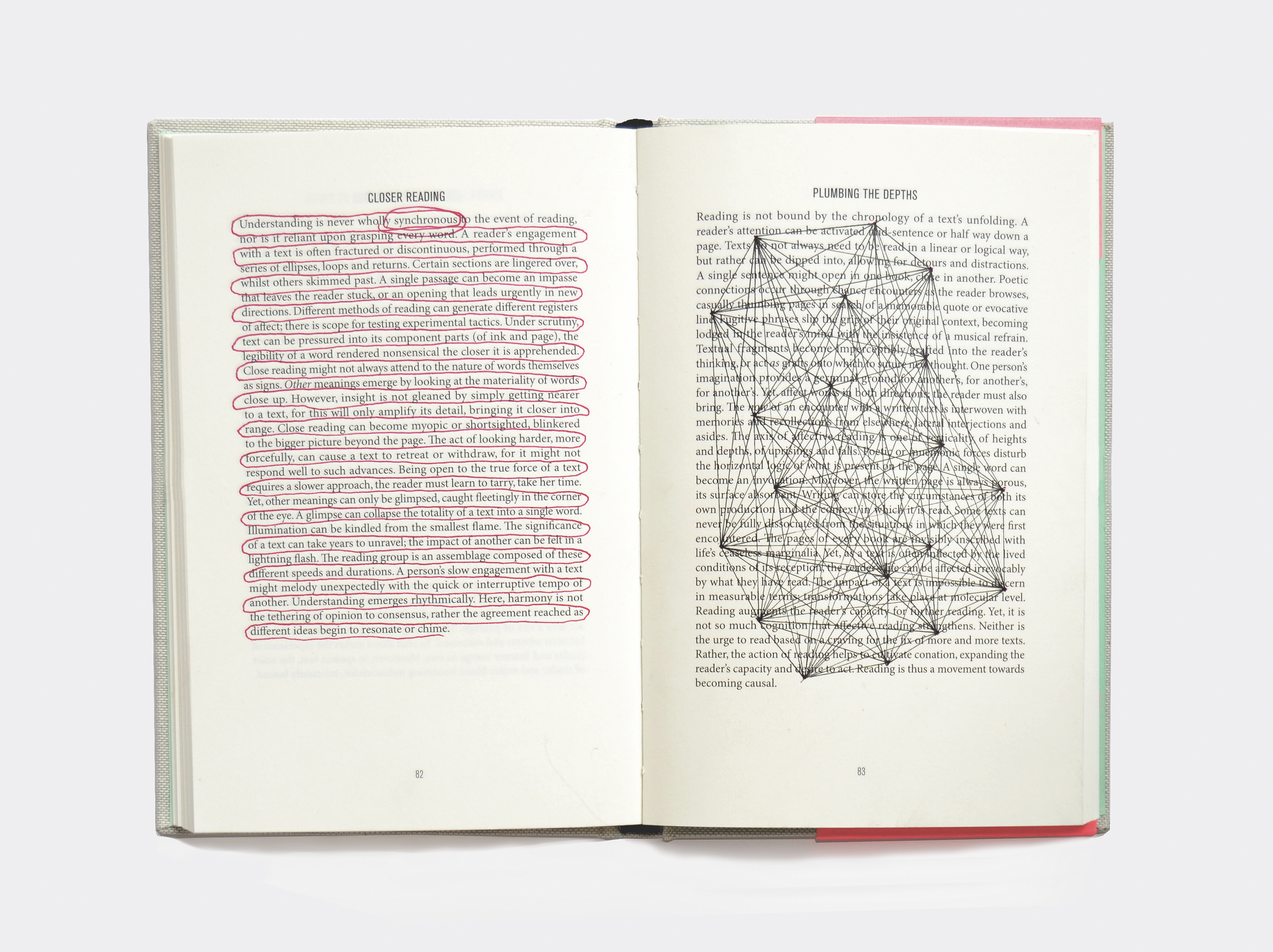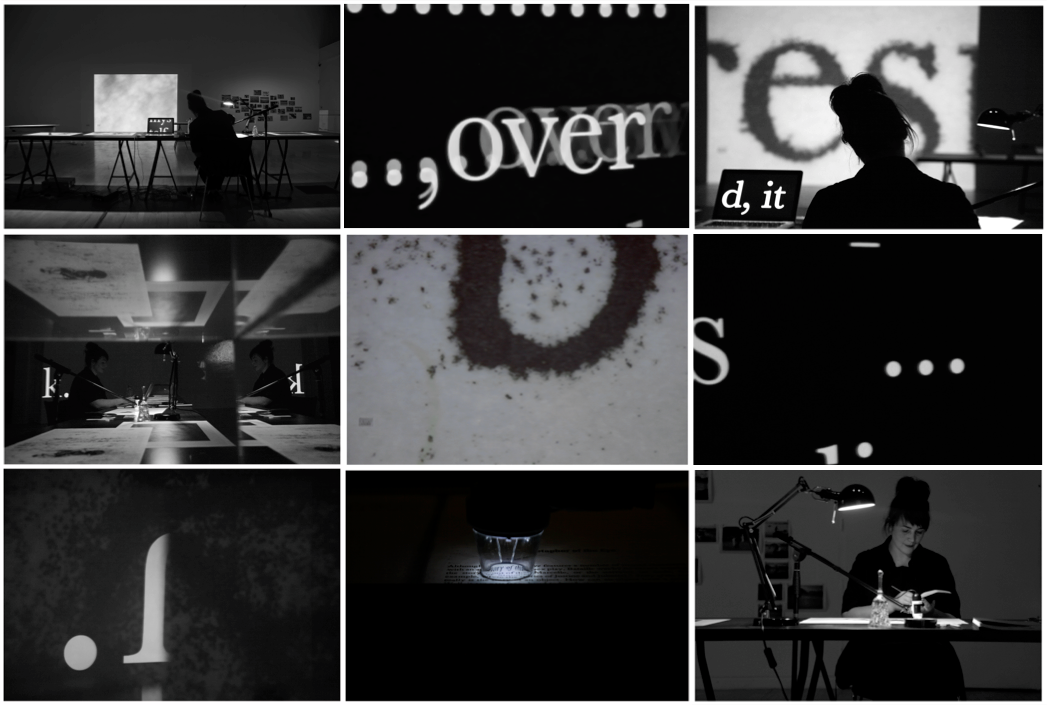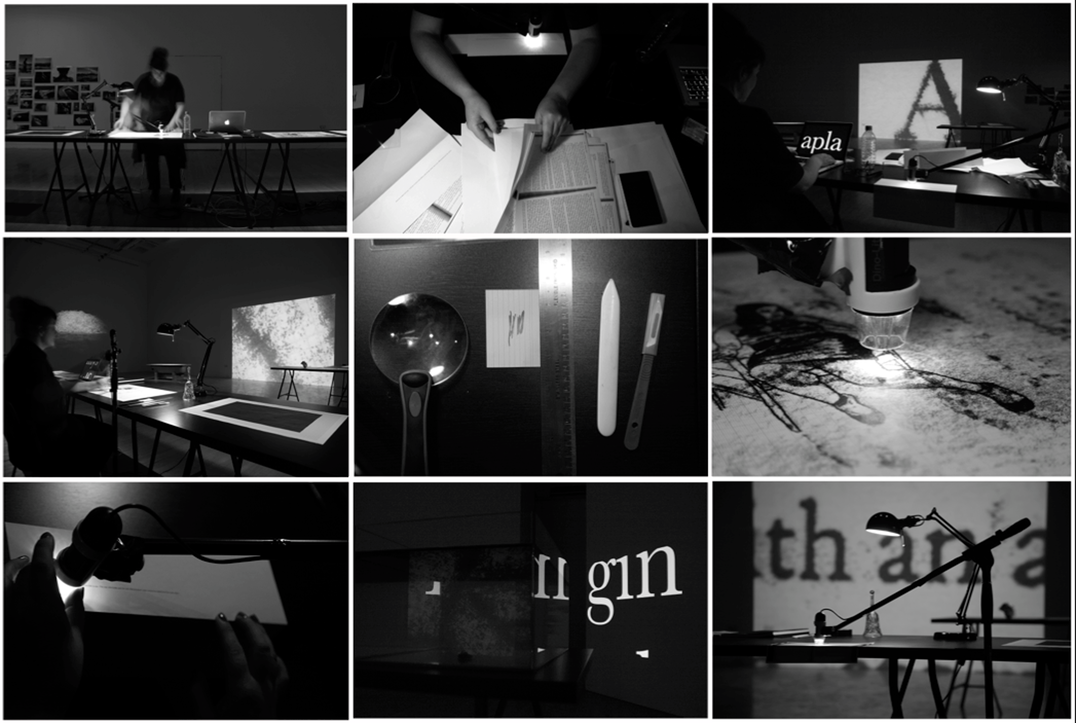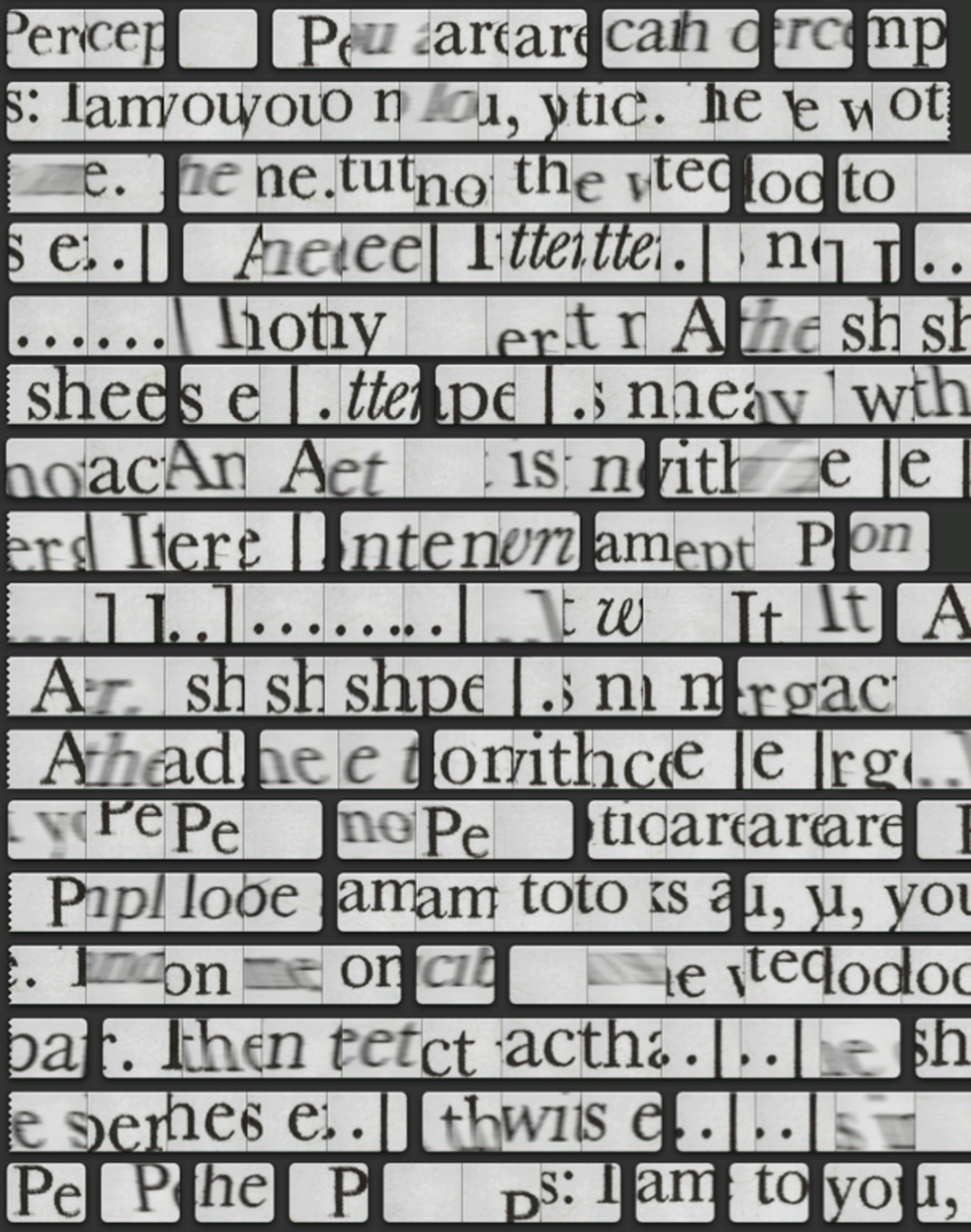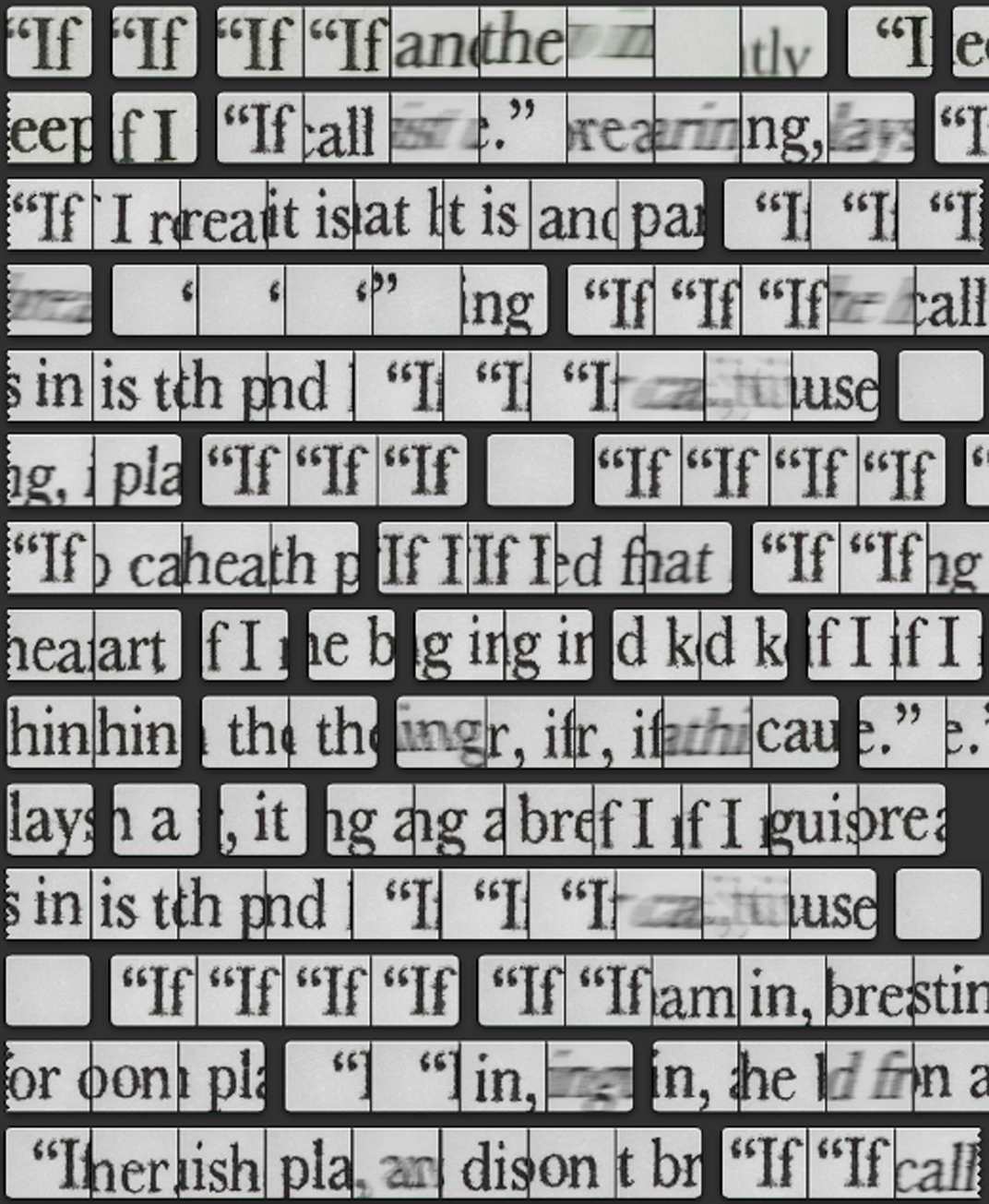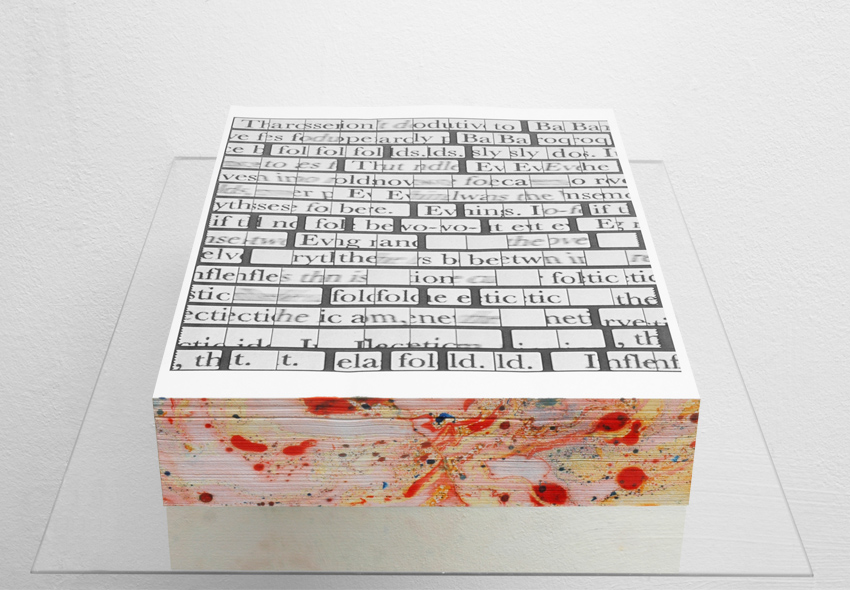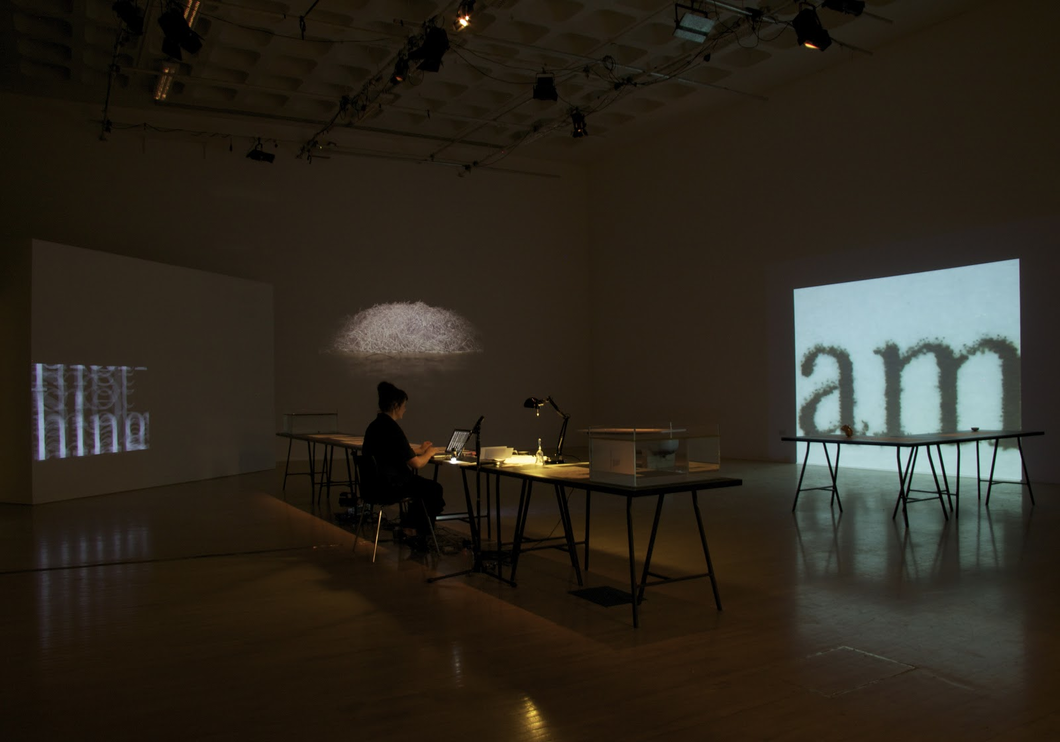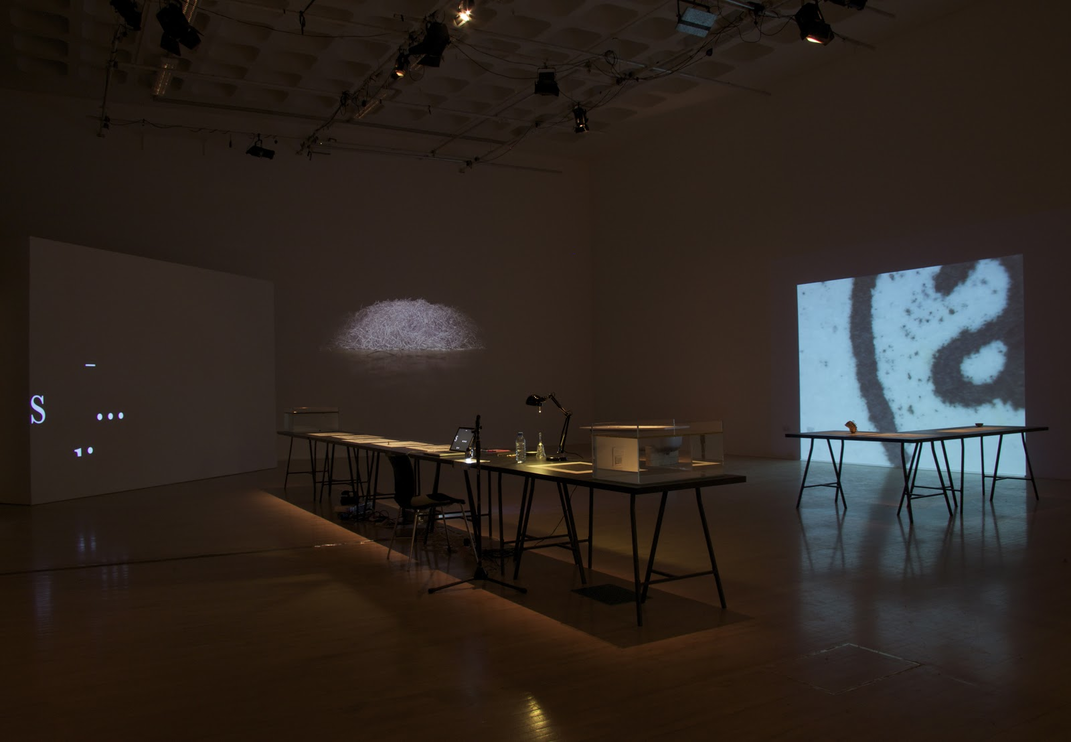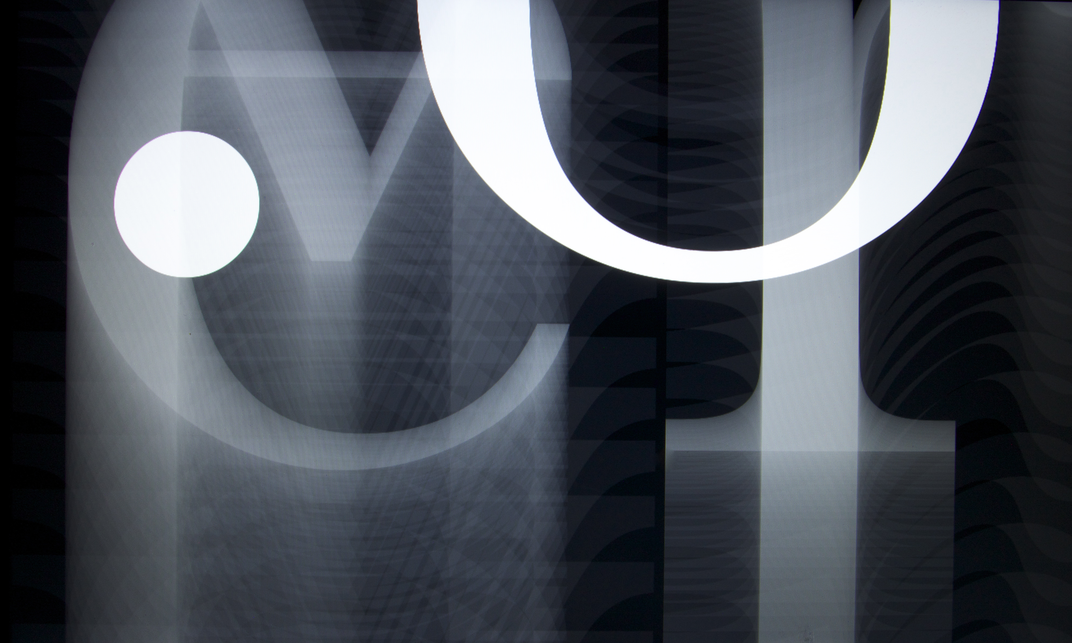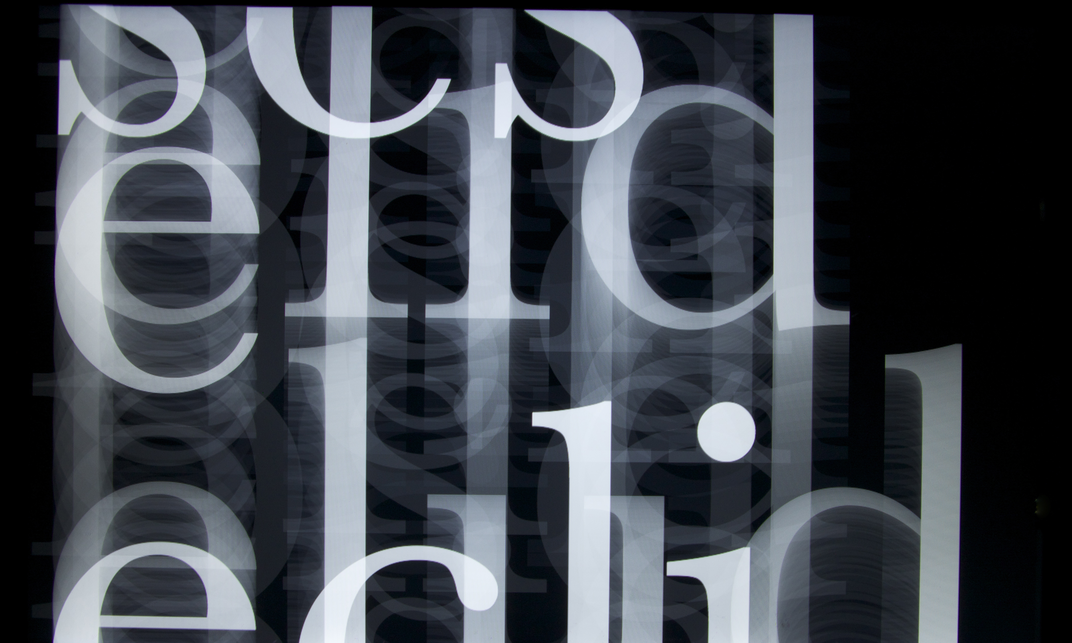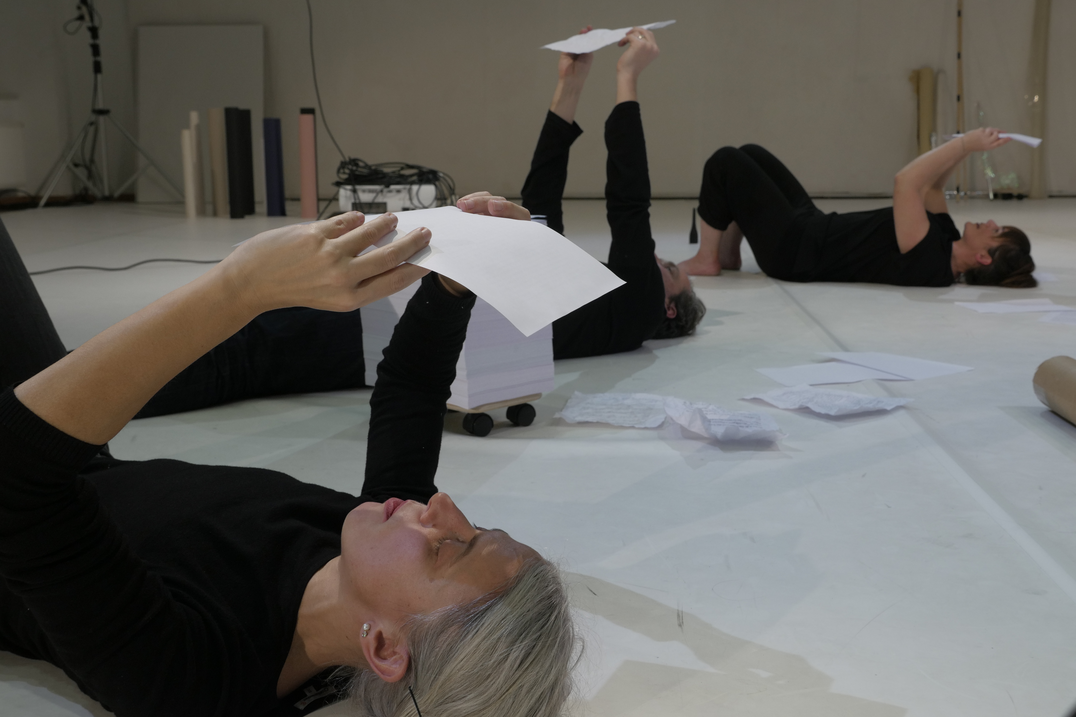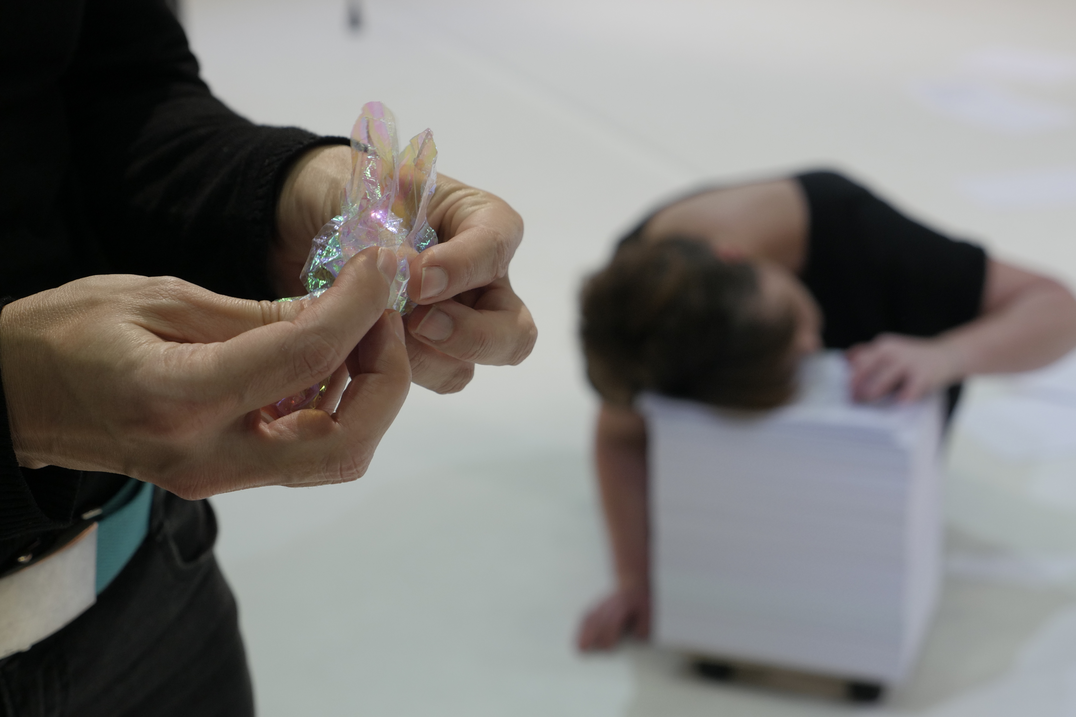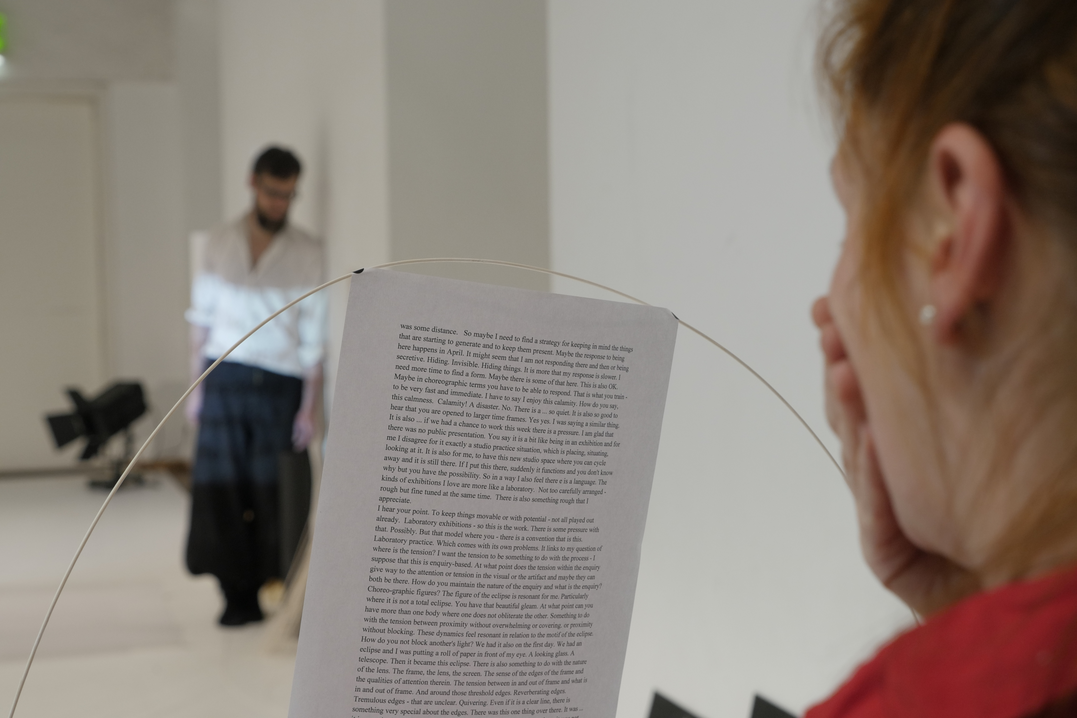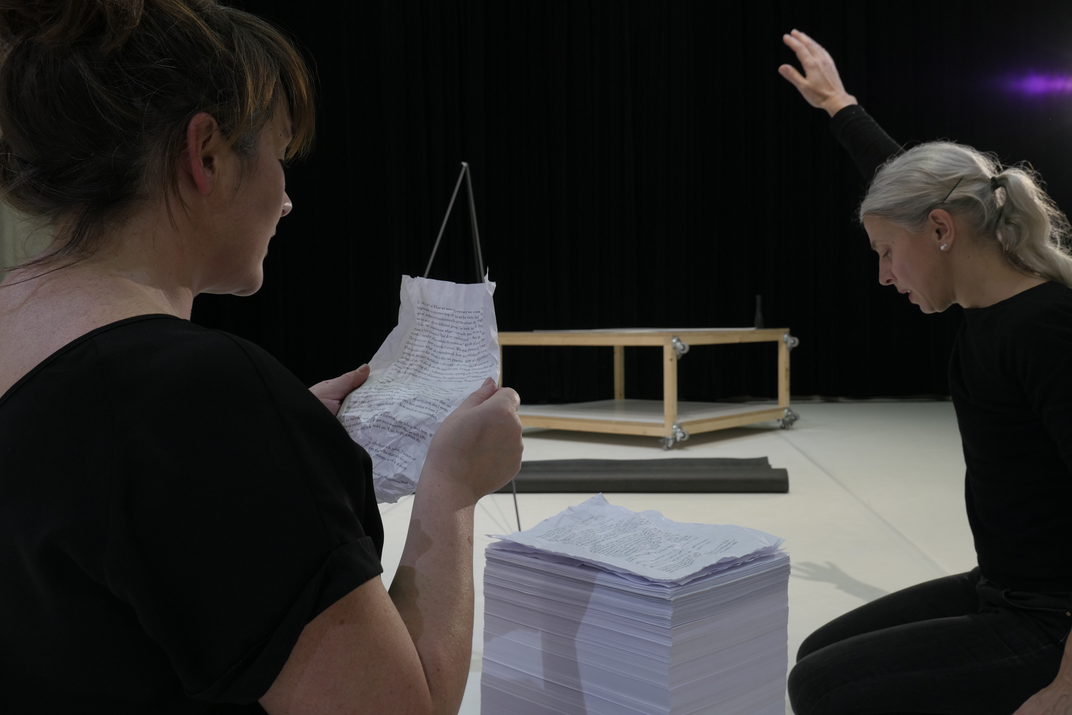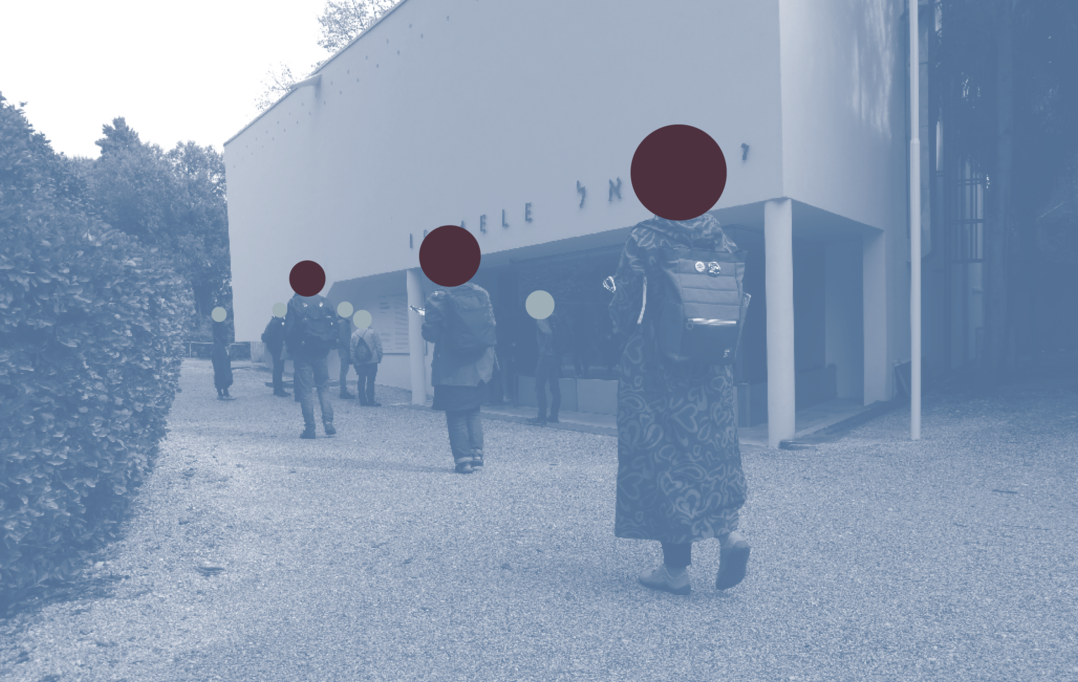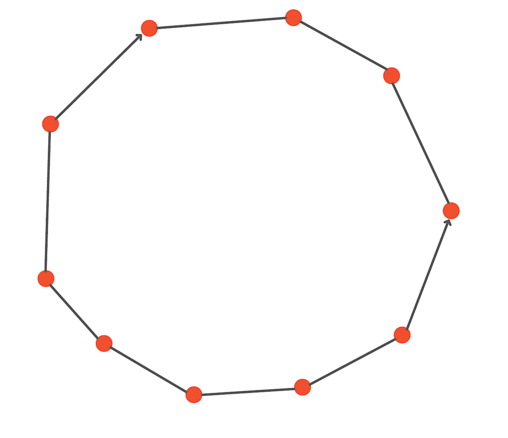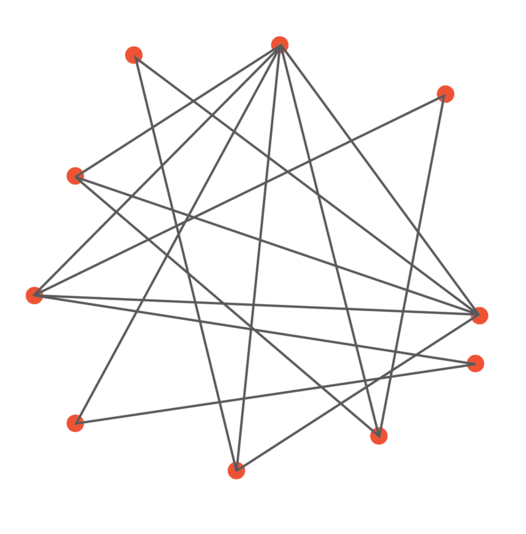POETICS OF ATTENTION
The shared practices of reading, Walking-Reading, Lapse Louding and Circuiting, are grouped together under the thematic, Poetics of Attention. This thematic emerges from and builds upon concerns and interests explored by Emma Cocker within the wider context of her research practice. Within this page, Cocker presents aspects of her own previous research enquiry in-and-through reading as a way of situating the 'reading on reading' project within a broader lineage of research activity. She draws on a series of projects developed over several years, where different reading practices have explored the 'poetics of attention' including: Reading / Feeling (2012); Close Reading (2011>); Choreo-graphic Figures (2014 - 2017), No Telos (2016>), alongside a series of research exercises (on reading's attentional field) undertaken in Venice (2019).
My own research interest in reading as an aesthetic practice especially in relation to the poetics of both attention and resistance, has evolved through a series of previous projects and collaborations (outlined below), which have in turn informed my approach to the project Reading on Reading: Ecologies of Reading. Or rather, my engagement in the collaborative project Reading on Reading, has enabled me to retrospectively identify and trace the presence of an already extant — if somewhat intermittant — enquiry around the aesthetic practice of reading that has been evolving gradually since 2011/12.
On reflection, my research interest in poetic, aesthetic as well as affective modes of reading was initiated in 2012 when (in partnership with If I Can't Dance I Don't Want to be Part of Your Revolution) I organised and hosted a series of reading group discussions at Site Gallery in Sheffield around the subject of Affect, as part of the If I Can’t Dance ... Edition IV — Affect (2010 - 2012).
Over a period of months, the reading group addressed various concerns: the constitutive role of the affective fragment or ‘refrain’1; the empathetic potential of affective memory; how the ‘affective turn’ might help shape the politics of everyday life, as well as affective labour and the politics of witnessing.2 Through our engagement with Michael Hardt’s question, ‘What are affects for?’3 we explored the potential instrumentalisation of affect, the scope for its mobilisation by the 'right', or else for being co-opted by academia ever in search of the next ‘turn’ within cultural discourse. Through the work of Félix Guattari 4 we considered how the “embracing of affect in social practice is ethical in that it evaluates practices of living … to take the everyday infinities and powers of affect very seriously; and to develop a creative responsibility for modes of living as they come into being”.5
Our engagement with the notion of affect through the prism of a specifically Deleuzian-Spinozist set of readings was a key catalyst in reflecting on what it might mean to not only read about affect, but also to read affectively.6 In his introduction to Gilles Deleuze’s, Spinoza: Practical Philosophy (1988), Robert Hurley argues that though the book is challenging, “... the situation is helped by the author's word to the wise: one doesn't have to follow every proposition, make every connection — the intuitive or affective reading may be more practical anyway.” 7 Here, Hurley considers that the book could be read like poetry.
But, how does one read affectively? What are the implications of encountering text affectively? How can a theoretical text be encountered in the same way as one might a poem, or even an exhibition, performance or piece of music? How can the practice of reading focus on what the encounter with a text opens up or out, rather than on what a text (or exhibition) means? We considered the potency of a glimpse of an idea within the act of reading, of the affective potential of skimming, or exposing oneself to a text’s affect rather than its signification. What registers of meaning and of thinking are produced through these different modes of encounter? This reading group purposefully advocated different intensities and durations of engagement with the reading material — asserting the value of glimpsing or skimming (or even electing to not read) alongside more conventional close reading methods.
Texts encountered during the reading group were later gathered as a ‘reader’, which also included written reflections by reading group members.8 I have included an extract from the text that I produced for this publication below, since it contains a number of propositions or sketches for experimental or even aesthetic reading practices, some of which have since been explored in practice. I have enboldened those parts of the text that resonate with the collaboration Reading on Reading, as well as the wider notion of ecologies of practice.
"Affect is necessarily apprehended from in its midst. Indeed, the reader’s body has been working with affect long before a decision is made to read a single sentence on this slippery subject. The reader’s body experiences the complexity of affect in advance of assigning it a name. Without recourse to language, the body articulates affect with a fluency that words find hard to follow. Other to the world of things and forms and functions, affect speaks of a different reality to that which is named and known. It is an inchoate realm of flows and forces — of gradients and intensities, of transitions and relations — which the body senses all too well, yet comprehension struggles to make sense [...]
Affect will not be grasped by intellect alone. Its frequency is non-discursive. Neither does affective reading involve the pursuit of knowledge, the accumulation of cognitive capital. Instead, it is performed as an intervention, as an active decision towards becoming one’s own cause. Affect involves reciprocity; the opening of a book requires the reader keeps an open mind. Suspicious reception must be replaced by receptivity, the willingness to be moved by another’s thoughts. Openness does not make the reader suggestible, susceptible only to the rhetorical or emotional tenor of a text. Rather it is an expression of readiness, the germinal ground for change or transformation. The affect reader momentarily suspends certain normative modes of reading, whose explication seeks to fix definitions too hastily, or which cut too quick an argument at its first failing or fault. Affect is not understood by being read about, rather reading is a constitutive practice within which affect is enacted, its flow felt. Reading is a site of rehearsal, where reader and text negotiate one another’s force. Its affective potential is thus amplified by reading in the company of others.
Collective acts of reading multiply the affective frictions generated by the rub of one individual’s thoughts with those of another. A text that moves a person towards thinking can prohibit someone else. A reader’s capacity can be both augmented and diminished through their encounter with the written page. Certain texts are toxins creating exhaustion and fatigue; others have the medicinal properties of a tonic. Reading together helps combat the adverse impact of a troublesome text. A struggle shared is halved. A group can be stronger than the sum of its parts. New meanings emerge in the gaps of prior knowledge. Common understanding is not the product of what is brought to a meeting of minds; rather, it is experientially co-produced through the process of encounter. Less a convivial site for the pleasurable reverie of reading, social interaction around a single text creates the experience of solidarity, the shared labour of sticking at something, working it through. Unexpected collectivities and allegiances are inaugurated in meetings on a page; new constitutions born in reading’s mutual witnessing. To bear witness to another’s endeavour makes it an occasion. The ritual presence of observers transforms reading’s private act into a rite of passage. The passage given voice dissolves the line between witness and witnessed. To read out loud makes the experience of reader and listener merge as one. Moreover, in spoken text, the voice of reader and writer bleed, becoming indissociable, intimately bound. Words are sonorous as much as signifying units. The soundness of a text tested by tongue and lips as much as by the mind. Certain language must be rolled in the mouth before it can be fully digested. Texts resonate at different frequencies according to their enunciation. New meanings are revealed by changed inflection, in the pauses and durations breathed between the words.
Understanding is never wholly synchronous to the event of reading, nor is it reliant on grasping every word. A reader’s engagement with a text is often fractured or discontinuous, performed through a series of ellipses, loops and returns. Certain sections are lingered over, whilst others skimmed past. A single passage can become an impasse that leaves the reader stuck, or an opening that leads urgently in new directions. Different methods of reading can generate different registers of affect; there is scope for testing experimental tactics. With practice, language can be made to stretch or pucker, pulled thin and sheer as delicate gauze or gathered up into thick and impenetrable creases. Under scrutiny, text can be pressured into its component parts (of ink and page), the legibility of a word rendered nonsensical the closer it is apprehended. Close reading might not always attend to the nature of words themselves as signs. Other meanings emerge by looking at the materiality of words close up. However, insight is not gleaned by simply getting nearer to a text, for this will only amplify its detail, bringing it closer into range. Close reading can become myopic or shortsighted, blinkered to the bigger picture beyond the page. The act of looking harder, more forcefully, can cause a text to retreat or withdraw, for it might not respond well to such advances. Being open to the true force of a text requires a slower approach, the reader must learn to tarry, take her time. Yet, other meanings can only be glimpsed, caught fleetingly in the corner of the eye. A glimpse can collapse the totality of a text into a single word. Illumination can be kindled from the smallest flame. The significance of a text can take years to unravel; the impact of another can be felt in a lightening flash. The reading group is an assemblage composed of these different speeds and durations. A person’s slow engagement with a text might melody unexpectedly with the quick or interruptive tempo of another. Understanding emerges rhythmically. Here, harmony is not the tethering of opinion to consensus, rather the agreement reached as different ideas begin to resonate or chime.
The affect reader is not bound by the chronology of a text’s unfolding. A reader’s attention can be activated mid-sentence or half way down a page. Texts do not always need to be read in a linear or logical way, but rather can be dipped into, allowing for detours and distractions. A single sentence might open in one book, close in another. Poetic connections occur through chance encounters as the reader browses, casually thumbing pages in search of a memorable quote or evocative line. Fugitive phrases slip the grip of their original context, becoming lodged in the reader’s mind with the insistence of a musical refrain. Textual fragments become imperceptibly grafted into the reader’s thinking, or act as grafts onto which to suture new thought. One person’s imagination provides a germinal ground for another’s, for another’s, for another’s. Yet, affect works in both directions; the reader must also bring. The now of an encounter with a written text is interwoven with memories and recollections from elsewhere, lateral interjections and asides. The axis of affective reading is one of verticality, of heights and depths, of uprisings and falls. Poetic or mnemonic forces disturb the horizontal logic of what is present on the page. A single word can become an invocation. Moreover, the written page is always porous, its surface absorbent. Writing can store the circumstances of both its own production and the context in which it is read. Some texts can never be fully dissociated from the situations in which they were first encountered. The pages of every book are invisibly inscribed with life’s ceaseless marginalia. Yet, as a text is often inflected by the lived conditions of its reception, the reader’s life can be affected irrevocably by what they have read. The impact of a text is impossible to discern in measurable terms; transformations take place at molecular level. Reading augments the reader’s capacity for further reading. Yet, it is not so much cognition that affective reading strengthens. Neither is the urge to read based on a craving for the fix of more and more texts. Rather, the action of reading helps to cultivate conation, expanding the reader’s capacity and desire to act. Reading is thus a movement towards becoming causal".
1.Lone Bertelsen and Andrew Murphy, ‘An Ethics of Everyday Affinities and Powers: Félix Guattari on Affect and the Refrain’ in The Affect Theory Reader, 2010, pp.138 – 157.
2. Michael Hardt’s Affective Labour, boundary 2, Vol. 26, No. 2 (Summer, 1999), pp. 89 - 100, and Jan Verwoert’s 'You Make Me Feel Mighty Real: On the Risk of Bearing Witness and the Art of Affective Labour' in Tell me what you want, what you really, really want, (Berlin / New York: Sternberg Press, 2010).
3. Michael Hardt, 'Foreword: What are Affects Good for?', in The Affective Turn: Theorizing the Social Turn (ed.) Patricia Ticineto Clough, (Durham: Duke University Press, 2007), pp.ix – xiii.
4. Félix Guattari, ‘On The Production of Subjectivity’, in Chaosmosis: An Ethico-Aesthetic Paradigm, (Indiana University Press, 1995), pp.1 – 33
5. Lone Bertelsen and Andrew Murphy, ‘An Ethics of Everyday Affinities and Powers: Félix Guattari on Affect and the Refrain’, in The Affect Theory Reader, p.141.
6. See Gilles Deleuze, Lecture on Spinoza’s Concept of Affect, (Cours Vincennes, 1978), and 'Spinoza and Us' (taken from Gilles Deleuze, Spinoza: Practical Philosophy, (San Francisco: City Lights Books, 1988).
7. Robert Hurley in Deleuze, Spinoza: Practical Philosophy, 1988, pp.i–iii.
8. The publication, Reading / Feeling considers the meaning of affect in theory and artistic practice, with a selection of texts by theoreticians, artists and curators that were read in If I Can’t Dance, I Don’t Want To Be Part Of Your Revolution’s reading groups in Amsterdam, Toronto and Sheffield as part of the programme Edition IV—Affect (2010–2012).
Text extracts below from Emma Cocker, 'Reading Towards Becoming Causal', in Reading / Feeling, Tanja Baudouin, Frédérique Bergholtz, Vivian Ziherl, (eds.) Reading Feeling, (Amsterdam: Idea Books / If I Can’t Dance I Don’t Want to be Part of the Revolution, 2013), pp. 21 - 24.
Close Reading investigates how paying close attention to language does not always fix or clarify a single, stable meaning, but perhaps counter-intuitively produces further uncertainty, indeterminacy and formlessness. Here, the more something becomes scrutinised the less it becomes known. This research enquiry is concerned with pushing or pressuring language beyond the regime of signification, in order to explore the affective and asignifying potential — or perhaps even poetics — of textual fragments.
Close Reading, C. O. P. V.
This is a 'close reading' of poet Charles Olson's Projective Verse (1950), and in particular the line "If I hammer, if I recall in, and keep calling in, the breath, the breathing as distinguished from the hearing, it is for cause, it is to insist upon a part that breath plays in verse".
Close Reading, L. I. T. B. T.
This is a 'close reading' of Luce Irigaray's, To Be Two, (London: Taylor and Francis, 2017), which was one of the texts that I 'close read' as part of my experience as a 'seer-in-residence' within Traci Kelly's Feeling it for You exhibition (see details below).
I began to further test Close Reading as a 'live event' as part of my involvement as an invited ‘seer-in-residence’ within the frame of Feeling it for You (Perspective), an exhibition by Traci Kelly, (Bonington Gallery, Nottingham, 2013). During this micro-residency, the process of Close Reading was accompanied by a practice of Live Writing. Live Writing sits in the space between reading and writing, or rather it describes the gestural movement of reading within the act of writing: the casual, sometimes distracted, flick and skim read of notes written on a computer screen which functions as a kind of lubricant for thinking. Live Writing has since evolved/is evolving as a working method for continuing my exploration of skimming, scanning and the visual encounter with words ‘close up’. In the flick and skim of both writing and reading, words themselves are not always distinguishable as discrete signifying units but instead appear liquid, their sense indeterminate, meaning blurred.
“The essence of language is to be articulated. Such articulations can be as smooth as one wishes; they are no less divisive for all that. In order to language to function, signs must be isolable one from the other (otherwise they would not be repeatable). At every level (phonetic, semantic, syntactic, and so on) language has its own laws of combination and continuity, but its primary material is constructed of irreducible atoms (phonemes for spoken language, and for written, signs whose nature varies according to the system in question: in alphabetic writing, for example, the distinctive unit is the letter). Whoever says ‘articulation’ always says, in the final instance, ‘divisible into minimal units’: the articulus is the particle. Language is the hierarchical combination of bits. Liquid, on the contrary … is indivisible”.1
Close Reading + Liquid Writing, performing process as part of my role as a 'seer-in-residence' within the exhibition Feeling it for You (Perspective) by Traci Kelly, Bonington Gallery, Nottingham. Photographs by Julian Hughes.
This ongoing project shares concerns with the reading practice of Lettering that we tested within Reading on Reading, however, rather than focusing 'close up' on the sonic and phonic aspects of language, in this work I attend more to the visual and physical materiality of language, which includes attending to the point where text collapses into ink/page (in Close Reading) or even pixels on a screen (in Live Writing).
Close Reading is an ongoing series of explorations (2011 >) which plays on the practice of 'close reading' or of 'explication de texte' as a critical tool for destabilising the linear unfolding of a text into discontinuous fragments. Like conventional forms of close reading, this work focuses on paying attention to individual words and the order in which sentences and ideas unfold as they are read or presented, drawing on the Latin origins of the word explicare which means to unfold, to fold out, to set forth. However, critical attention is not paid to the meaning of words themselves as signs, but to those other meanings produced by looking at the materiality of words 'close up', by applying close visual attention to language, through processes of visual magnification or microscopic observation.
Emma Cocker as ‘seer-in-residence’ within the frame of Feeling it for You (Perspective) by Traci Kelly, (Bonington Gallery, Nottingham, 2013)
Liquid Writing, Video and photographic stills from the video. In the stills the pixelation of language on the screen becomes more pronounced, reflecting a collapse of language into its material ground. 2013.
1. Yve Alain Bois, 'Liquid Words', in Formless: A Users Guide, Yve Alain Bois and Rosalind Krauss, (eds) (Zone Books, 1997, p.124).
In parallel within the project reading, practices were conceived as part of a wider exploration called the Figure of Ventilating Meaning, in which we collectively attempted to liberate language from the regime of signification and informational exchange towards an embodied poetics. Within this shared enquiry, words were transformed through the reverberation of speech and voice, the embodiment of text — the act of rolling language around in the mouth as a physical practice. The starting point for this field of language-based exploration were a series of conversational transcripts from our three-year artistic research project, approached as live material for playful appropriation and reworking. Our emphasis was on activating language through rhythmic, relational speech acts: through the affect of breath and air bringing qualities of lightness and aeration, the babble of overlapping voices reading together, echoes and translations, stutters and repetitions, whispered conversations assembled from dislocated fragments of text.
1. Choreo-graphic Figures: Deviations from the Line involved a beyond-disciplinary, inter-subjective encounter between the lines of choreography, drawing and writing, for exploring those forms of ‘knowing-thinking-feeling’ produced through collaborative exchange, in the slippage and deviation when different modes of practice enter into dialogue, overlap and collide. The research project was conceived and developed by three key researchers: myself, writer-artist Emma Cocker, artist-performer Nikolaus Gansterer and dancer-choreographer Mariella Greil. Along the research journey, we — the key researchers — worked closely with critical interlocutors Alex Arteaga, Christine De Smedt and Lilia Mestre, alongside guest collaborators Werner Moebius and Jörg Piringer. For a full account of the Choreo-graphic Figures project see the project publication Emma Cocker, Nikolaus Gansterer, Mariella Greil, Choreo-graphic Figures: Deviations from the Line (Berlin: de Gruyter, 2016), a selected sample of which can also be found here. See also Choreo-graphic Figures: Scoring Aesthetic Encounters, in JAR - Journal of Artistic Research, Issue 18, Summer 2019, https://www.researchcatalogue.net/view/462390/462391
My interest in the potential of reading as an aesthetic practice was further tested and explored within the frame of the collaborative artistic research project Choreo-graphic Figures: Deviations from the Line (2014 - 2017).1 One aspect of this shared enquiry involved testing various expanded language-based practices, where the potential of reading, conceived as a poetic-aesthetic practice, was explored in two distinct ways:
Firstly, reading was conceived as a potential 'Practice of Attention'. The 'Practices of Attention' — also including breathing, walking, voicing, sleeping — were conceived as enabling, helping us to attune to and access states of increased alertness, vigilance and receptivity, in turn augmenting (heightening, deepening, widening) and nuancing (sharpening, refining) both our individual and collective sensitivities to the vitality dynamics and affects within our live explorations.
The reading-based 'attention practices' first emerged within the frame an 'Intensive' workshop, Modes of Language: Words as Material, that the Choreo-graphic Figures project, developed as part of the Visual Arts X Dance workshop programme, ImPulsTanz, 2016. The aim of such practices was 'just reading' — the reading must be empty, words encountered lightly not grasped towards. For example:
Textual Body Scan
Take a printed page of text — any will do. Imagine the page as if it were your body. Take your attention to the foot of the page, the bottom lines. Allow your eyes to gently encounter the words. Without reading them, just observe what is there. Now slowly, move your attention up through the text, from the bottom to the top, sentence by sentence. Left to right, then right to left. Moving upwards gradually, as if you were shifting your awareness from your feet up through your body to your head. As your attention reaches the top of the text, read out loud the last word upon which your eyes settle. Now, let go of the text.
Figure of Ventilating Meaning, documentation of Emma Cocker, Nikolaus Gansterer, Mariella Greil, Werner Moebius, Lilia Mestre engaged in live exploration during Choreo-graphic Figures, Winter Lab, TanzQuartier, 2015.
READING AS A POETIC-AESTHETIC ACT
My own enquiry around reading as an aesthetic practice — or even as a poetic-aesthetic practice — has become more crystallised since reading Michelle Boulous Walker’s Slow Philosophy: Reading Against the Institution (2017).
In Slow Philosophy, Boulous Walker critiques the utilitarian tendencies of the contemporary academy and its institutional modes of reading, all too often modeled on the grasping of information as resource for future citation. She asks “What are the implications of this institutional practice for the quality of attention we are able to sustain and the reading practices that come from it?”1 For Walker, such utilitarian approaches to reading fail to open the reader up to be transformed by a text, by philosophy. For Walker, slow reading is an ethical and political practice through which to engage with complexity, difficulty and even strangeness, against the demands of an institutional and cultural context whose instrumentalised forms of reading are underpinned by speed, efficiency and productivity. Drawing on the writing of various thinkers including Luce Irigaray, Hélène Cixous and Simone Weil, Boulous Walker advocates a practice of ‘slow reading’ that requires the sustained act of returning to, reassessing, reconsidering and re-engaging with a text in order to cultivate a relational attentiveness based on intensity, intimacy, and proximity, for generating a receptive capacity in the reader for openness to otherness.2 Here, slow modes of engagement enable the potential for transformation rather than simply acquisition.
For Boulous Walker, “Reading slowly and rereading, returning time and time again to read anew, we return, similarly to the things in the world anew [...] slow reading would not simply mean always reading slowly, but would, rather, involve a preparedness to return time and time again to what we read".3 The practice of reading carefully, of rereading and of returning to what one reads, is conceived as a means through which to “re-engage the instituting moments of philosophy as a love of wisdom” (or even the wisdom of love) and “as a way of life, rather than simply as a desire (or need) to know”.
Emma Cocker, Split Attention 'poem'. In this process I record the practice of Split Attention, transcribe it, and the transcription becomes a chance poem (see above).
Begin with a practice round. Take a few moments to scan your chosen text. Select a sentence or a short line of the text or even a couple of words. One person begins by reading their chosen fragment out loud. Going in a clockwise direction, the next person in the circle reads their chosen fragment out loud. Continuing in a clockwise direction, the next person in the circle reads their chosen fragment out loud. And so on. Periodically switch direction, reading in an anticlockwise direction. Experiment with different speeds and slowness. Experiment with different volumes, loud to quiet and the gradations in between. Experiment by reading all or just a part of your chosen line. Establish some fluidity or flow. When the time feels right, stop.
Repeat the experiment as above, but now make the selection of your sentence or line of text as a live act. Rather than sticking with the same fragment, choose new sentences or lines of text to read as the experiment unfolds. You could begin at the start of your text — simply stopping and then starting again at the point at which you left off. Or shift from page to page, reading a discontinuous selection of fragments. One person begins. Choose a sentence or line of text and read it out loud. Going in a clockwise direction, the next person in the circle reads their chosen fragment out loud. And so on. Experiment by reading all or just a part of your chosen line. Experiment by leaving your sentence open, unfinished. Experiment by starting to read your sentence half way through. Consider the cuts and segues — where to begin and where to end. Establish some fluidity or flow. Now, switch to ‘passing’ the ‘turn’ to read across the circle by meeting another’s eye. Keep one eye open in readiness to respond to the ‘call’ to read, one eye on your text receptive to the ‘call’ of the letters, alert to the emergent possibilities of the next line.
The various reading exercises tested and developed within the project No Telos were conceived originally as having no telos, as operating against the goal-oriented and target-driven imperative culture and especially of academic life. However, as the project evolved it became more generative to conceive such activities less through the negative prism of 'no', but rather in a neutral form of atelic, or perhaps even richer still, as a species of autotelic practice. Autotelic activities also refuse the reward-driven, outcome-motivated tendencies of contemporary culture, however, they are not pitched in antagonistic relation to the idea of a goal or end: they are not against telos as such. Autotelic (autos—‘self’ and telos — ‘goal’) refers to an activity or a creative work that has an end or purpose in and of itself. Autotelic activity exhibits a sense of intrinsic meaning or curiosity — that is internal to it, emerging through it — where the sense of its worth or value is not established or measured according to external criteria. How are the differences in sense-making if reading is undertaken in relation to a telos, end or goal; as a non-teleological (endless, aimless) activity; as an atelic practice, or else experienced as autotelic activity?
1.No Telos is a collaborative artistic research project for exploring the critical role of uncertainty, disorientation, not knowing and open-ended activity within creative practice and during uncertain times. No Telos was initiated in 2016 by a group of artists including Andrew Brown, Emma Cocker, Katja Hock, Danica Maier, Andy Pepper and Derek Sprawson. In 2017, No Telos staged a research intervention in Venice against the wider contextual frame of the 57th Venice Biennale, for questioning contemporary modes of artistic production through a week-long intensive residency. During this phase of the project, the original No Telos group were joined by artists Steve Dutton, Tracy Mackenna and Susan Trangmar (as critical friends or interlocutors) and Susi Clark and Elle Reynolds (as documenters-witnesses of the unfolding process). Documents and materials arising through this collaborative research project were gathered as part of an artists’ publication. This artists’ book comprised a series of ‘scores’, drawing on exercises and practices first developed and tested in Venice (2017), where the city is approached as a working ground or live laboratory for artistic research and aesthetic investigation, for poetic inscription and playful experimentation. The publication was launched in Venice (June 2019) through a series of participatory actions, readings and animated extracts for activating the scores, within the event Convocation, in frame of the Research Pavilion and against the wider context of the 58th Venice Biennale. A digital version of the publication, contextualised through further documentation and reflection will be cumulatively developed here -https://www.researchcatalogue.net/view/611078/611079
2. The texts that I was using for the reading practices in Venice as part of No Telos included Byung-Chul Han, ‘Time without Scent’, pp.12 – 19; ‘The Paradox of the Present’, pp.36 – 41; ‘The Scent of Oak Wood’, pp.69 – 77, all from The Scent of Time: A Philosophical Essay on the Art of Lingering, (Cambridge: Polity Press, 2017), Michelle Boulous Walker, ‘Preface: Why Slow Reading Today? in Slow Philosophy: Reading Against the Institution, (London: Bloomsbury Academic, 2017), pp.xii – xxiv, Georges Perec, ‘Reading: A Socio-physiological Outline’ in Species of Spaces and Other Pieces translator John Sturrock, (London: Penguin Books, 1974/1997), pp.174 – 185, Christoph Brunner, ‘Slow Practices – 11 Theses’, in Practices of Experimentation: Research and Teaching in the Arts Today, (Zürich: Scheidegger & Spiess, 2012), pp. 56 – 67; Harold Schweizer, On Waiting, (London: Routledge, 2008).
I have since developed the reading practices initiated during No Telos through a series of workshops and seminars in different contexts including: Critical Poetics seminar, Nottingham Trent University, (8 May 2018); a 2-day Language-based workshop-seminar at the Kunst Musikk Design Faculty of Arts [kmd] in Bergen, Norway (29 – 31 October 2018), a 2-day seminar within the PhD course Concepts, Theories, Experimental Practices with Professor Hélène Frichot in Stockholm (9 – 10 April 2019). During these workshops I used additional textual references for the reading practices including Esther Leslie, ‘Moving Words: Facts of Reading’, in Torque: The Act of Reading, (eds.) Nathan Jones and Sam Skinner, (Liverpool / London: Torque Editions, 2015), pp.73 – 96. ‘Metaphors of Reading, pp. 163 – 173, ‘The Browser’s Ecstasy’ pp. 53 – 73, in Geoffrey O’Brien, The Browser’s Ecstasy, (Washington : Counterpoint, 2003); Michelle Boulous Walker, ‘Reading Essayistically: Levinas and Adorno, pp.55 – 73; Thomas Campbell and Simon Morris, 'Reading as Art', in Postscript: Writing After Conceptual Art, (ed.) Andrea Andersson, (Toronto ; Buffalo ; London University of Toronto Press, 2018), pp. 336 – 341; Virginia Woolf, ‘How Should One Read a Book’, in The Common Reader (2nd Edition), (London : Vintage Digital, 1925/2015), pp.258 – 271.
Recording: 6 readers practising Noticing Attention, in the Giardini of the Venice Biennial 2017, extract 1:54 min.
II: Walking Reading
Find a location with space to wander. Take some printed pages of text or an open book. Hold the text gently in your hands. Allow your shoulders to relax and soften; feel your feet as they meet with the ground. Begin to walk, slowly. Take your attention to the words on the page, reading slowly, with care. Pace the speed of your reading to the rise and fall of your feet, of your breath. Take your time. Slow down your reading further: read one word at a time, then letter by letter. How does this change the rhythm of your steps? Now, increase the speed of your walking — does the speed of your reading change? Experiment. Tune in to the rhythms of both reading and walking. Let go of any sense of destination or direction.
[The reading practice Walking-Reading was tested further during Reading on Reading].
Walking Reading in the Giardini, Venice Biennale, September 2017. Original photograph by Elle Reynolds.
III: Split Attention
Take some printed pages of text or an open book. Hold the text gently. Allow your eyes to roam the text until they alight on a word that prickles your interest. Write this word down in clear capital letters e.g. ALEATORY. Now, return to reading the text that you are holding, beginning with the first line, using your ‘inner voice’, reading silently ‘in your head’. When you encounter a word beginning the first letter (e.g. A) of your chosen word (e.g. ALEATORY), say it out loud. Then, carry on reading with your inner voice. Continue to identify words beginning with this letter (e.g. A) saying them out loud as you encounter them, until you spot a word beginning with the next letter of your chosen word (e.g. L). Say this word out loud. Continue this process until you have worked your way through all the letters of your chosen word. If you cannot find a word corresponding to a particular letter, then remain silent. Explore this practice in the company of others. Attend to the emergent poetics produced through the chance encounter of spoken words.
The research project No Telos (2016 >) provided a further context within which I have continued to explore the notion of reading as an aesthetic practice with a focus on both its poetic, affective and even disruptive-resistant potential.1 The project considers different tactics for resisting the increasingly outcome-motivated or achievement-oriented tendencies of contemporary culture, by shifting emphasis from a mode of telos- or goal-driven productivity towards experimental forms of process-led exploration, subversive playfulness and willful irresolution.
Within this research project, my own enquiry unfolded through a series of ‘reading experiments’ for exploring both the ‘how’ and ‘how else’ of reading. Within No Telos, my interest in reading practices evolved into a 'reading on reading' approach — where experimental forms of reading were applied to various texts about reading as well as slowness.2 The research process unfolded through a series of experiments that I tested with fellow researchers in the Giardini, Venice Biennale. For example:
I: Noticing Attraction
Take a different printed page of text or an open book. Allow your attention to roam the page, moving freely, or in a spiralling movement from the centre of the page outwards. Soft attention, floating across the surface. Not reading for sentence sense, just noticing. When a word catches your attention, mark this impulse with a sign, a click or clap or other gesture. Repeat this process until you feel ready to let the text go.
IV: Circuitous Sense Making
This experimental reading is for more than one reader. Make a selection of around a dozen or so books: they could be chosen in relation to a specific theme e.g. reading or slowness; to a specific field of practice e.g. phenomenology, or could simply be picked randomly from the shelves of your studio or from the library. They could all contain a shared word in their title e.g. Poetics; or different readers could each bring a book of their own selection.
Find somewhere to sit or stand, somewhere to explore reading out loud together. Gather in a small group. Gather close or in a circle: make sure that you can meet one another’s eye. Each person selects one of the books/texts that have been chosen.
Moreover, slow reading has an ethical dimension, where unhurriedness emerges as a precondition for being more available, receptive and open to the other, as well as to the experience of ambiguity, strangeness and uncertainty. Walker argues that slow reading unfolds as “an attentive rereading rather than a speed reading; as common or unprofessional reading rather than a professional one; as an open or open-ended reading rather than a finite one; as an exploration of ambiguity and contradiction rather than a need to know; as an imaginative engagement rather than a disciplined approach; as an experimental gesture rather than a rigorous one; as a fascination rather than a final interpretation; as an intellectual curiosity rather than an explanation; as an incomplete reading rather than a final one; as a partial account rather than an exhaustive one; as a suspended judgment rather than a verdict; as an essayistic reading rather than a systematic one; as a loving relation or wondrous appreciation rather than an authoritative account; as an attentive listening rather than a closed mind; as a careful engagement rather than a reductive response; as an authentic reading rather than a romantic or deferential one; as a slow and intimate approach rather than a hasty reduction; as a generosity and a giving rather than a plundering; as a discerning reading rather than a self-interested one; as an intense encounter, an extreme proximity or an entredeux rather than an objective account; as a meandering, an unhurried reception, a reflection, a rumination, a meditative relation, a patience, a receptive attitude rather than an activity, a mastery or a mobilization; as a feeling, an atmosphere or mood rather than an academic exercise; as an attention, rapture, felicity, surrender or grace rather than the gravity of a calculation; as a future philosophy rather than an adversarial one; as an ethics of reading rather than a desire to know.”4
Ambiguity. Uncertainty. Patience. Proximity. Receptivity. Even vulnerability. These qualities seem necessary for artistic practice and research as much as philosophy. So, what is ‘slow reading’ for the artist and how might it be nurtured? I am interested in the relation of reading and time (the importance of unhurried reading, of reading that allows time for exploration); reading as an embodied, experiential process; reading as a transformative practice that changes us.
Indeed, like Boulous Walker I advocate the critical capacity of ‘doing deceleration’ as a means of resisting the impinging pressures of acceleration or rather of proliferation: the demands to do more and more — faster and faster — that arguably underpin our contemporary culture of immediacy and urgency, with its privileging of multitasking, perpetual readiness and ethos of ‘just-in-time’ production.5 However, as Hartmut Böhme argues in The Art of Deceleration, what we need is a “new wisdom that does not pit speed and slowness against each other”,6 for speed itself is not to blame but rather the restlessness, carelessness, inconsiderateness, vagueness, negligence, imprudence, impatience, and hurry that result when haste “tears us away from the present toward a destination”.7
I read Walker’s text with some sense of dilemma, for whilst I support her advocacy against instrumental forms of institutional reading, I am not sure that I am a slow reader in the way that she describes. I often have piles of books — at home, at my studio, in my bag — where reading unfolds through the movement between these various texts. Unsystematic reading — still, is there method in this messiness, in the movement between this page and that. When time is pressured, this feels a rather problematic way of reading — it can becomes dithery and procrastinating, hurried or panicky as a shallow breath. But if I have the time, and if the time is unhurried … there is a definite sense of practice. Reading slowly and deeply, yes. Yet, sometimes swiftly — reading with curious eyes, alert and urgent. Not just one book — two, three, four, innumerable. Piles of papers — scattered, disorderly. What emerges in the shifts and slippages from one text to another; in the chance encounter between words; in the gaps and intervals; in the breath; in the stumble and the pause? Drifting. Glimpsing. Skimming. Not for the instrumental grasp of information, but towards the poetics of reading emerging between the lines.8 Reflecting on Slow Philosophy I wondered: how do we read as artists, as writers, as poets? Against utility, against informational acquisition: what other modes of reading might we cultivate? Reading as resistance; reading as reparation, reading as experimental adventure.
Reading’s Attentional Field
As part of my wider research activity during the Research Pavilion, Venice, 2019, I also explored the attentional field of reading (the shifts of attention within reading between concentration, immersion and distraction) in relation to the where of reading. I practised reading in different site-specific locations in order to explore how/if an activity that I might anyway engage in (reading in different places) could constitute a ‘practice’.1 How do different situations and environments shape the experience of reading? Which situations and environments are conducive to reading — which kinds of conditions enable and which kinds constrain? How does background 'noise' create a desirable 'ground' against which to read — how are distraction and concentration activated in and through different sites of reading? How does reading create the idiorrhythmic conditions of both being-with and being apart? What does the practice of reading reveal about different situations and environments — how does reading create an attentional field through one might encounter or engage with a specific situation (differently)? I made various 'field-notes' at some of these different reading sites — through sound, video and written commentary.
1. For these practices, I was reading David Abram's Spell of the Sensuous: Perception and Language in a More-Than-Human World, (New York : Vintage, 1997), including the section 'Toward an Ecology of Language' in the chapter 'The Flesh of Language' pp.73 — 92, where Abram states "Only if words are felt, bodily presences, like echoes or waterfalls, can we understand the power of spoken language to influence, alter and transform the perceptual world", p. 89.
What different kinds of sense making are generated through different critical-poetic practices of reading? How does the how of reading — the very act, event or process of reading, perhaps even separate from what we read — organise us and shape our understandings? How might we reorganise ourselves differently through reading as an aesthetic act?
1. Michelle Boulous Walker, Slow Philosophy: Reading Against the Institution, (Bloomsbury Academic, 2017), p.14.
2. Boulous Walker, 2017, p. xxi.
3. Boulous Walker, 2017, p. xv.
4. Boulous Walker, 2017, p. 33.
5. In 2017, I co-organised the symposium ‘Doing Deceleration’ (4.7.2017) with Henk Slager, in conjunction with his exhibition Exhausted Academies at Nottingham Contemporary (30 June — 5 July 2017).
6. Hartmut Böhme, The Art of Deceleration: Motion and Rest in Art, (Berlin: Hatje Cantz, 2011), p. 1.
7. Böhme, 2011, p. 2.
8. In considering the ‘poetic’ dimension of these various reading practices and the forms of attention that they invite, I have been reflecting on Franco ‘Bifo’ Berardi’s writing on the resistance or irreducibility of poetry to data-information and exchange [See The Uprising: On Poetry and Finance, (Los Angeles, California: Semiotexte, 2012)]; Gaston Bachelard’s Poetics of Reverie (Boston Beacon Press, 2010), and Hélène Cixous’ ‘ecriture feminine’ or ‘writing the feminine’, a mode of poetic-philosophical writing that resists the restrictions and authority imposed by patriarchal language (e.g. Stigmata: Escaping Texts, (London; New York: Routledge, 1998). In all three references (though differently) there is an attempt to resist or undermine the (masculine) economy of production, accumulation and profit. How can reading set up a non-acquisitional space of encounter: against economic return — towards transformative reciprocity?
